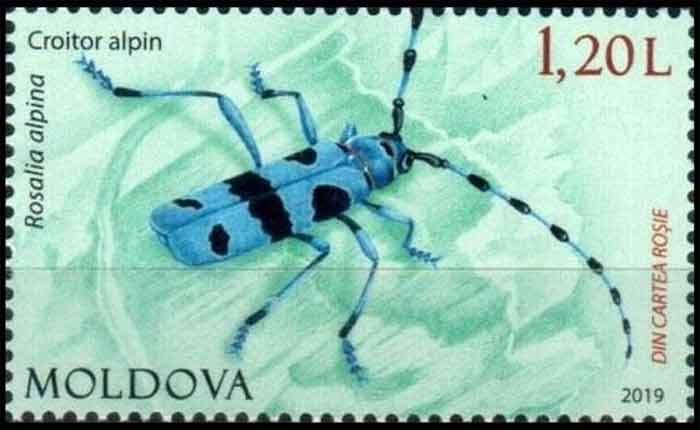
Rosalia alpina
Superregnum: Eukaryota
Cladus: Unikonta
Cladus: Opisthokonta
Cladus: Holozoa
Regnum: Animalia
Subregnum: Eumetazoa
Cladus: Bilateria
Cladus: Nephrozoa
Cladus: Protostomia
Cladus: Ecdysozoa
Cladus: Panarthropoda
Phylum: Arthropoda
Subphylum: Hexapoda
Classis: Insecta
Cladus: Dicondylia
Subclassis: Pterygota
Cladus: Metapterygota
Infraclassis: Neoptera
Cladus: Eumetabola
Cladus: Endopterygota
Superordo: Coleopterida
Ordo: Coleoptera
Subordo: Polyphaga
Infraordo: Cucujiformia
Cladus: Phytophaga
Superfamilia: Chrysomeloidea
Familia: Cerambycidae
Subfamilia: Cerambycinae
Genus: Rosalia
Species: Rosalia alpina
Name
Rosalia alpina (Linnaeus, 1758)
Original combination: Cerambyx alpinus Linnaeus, 1758

Rosalia alpina, Biology Stamps
References
Linnaeus, C. 1758. Systema Naturae per regna tria naturæ, secundum classes, ordines, genera, species, cum characteribus, differentiis, synonymis, locis, Tomus I. Editio decima, reformata. Holmiæ: impensis direct. Laurentii Salvii. i–ii, 1–824 pp DOI: 10.5962/bhl.title.542: 392. Reference page.
Rosalia alpina Taxon details on Fauna Europaea
Tribe Rosaliini: Rosalia alpina (L., 1758) – photo by Szczepan Ziarko
IUCN: Rosalia alpina (Vulnerable)
ZooBank: 043E1B18-E1B0-4052-8926-389AA1EEC682
Vernacular names
български: Алпийска розалия
čeština: Tesařík alpský
Deutsch: Alpenbock
English: Rosalia longicorn
français: Rosalie des Alpes
magyar: Havasi cincér
Nederlands: Alpenboktor
polski: Nadobnica alpejska
русский: Альпийский усач
slovenčina: Fuzáč alpský
The Rosalia longicorn (Rosalia alpina) or Alpine longhorn beetle, is a large longicorn (family Cerambycidae) that is distinguished by its distinctive markings.
Description
Rosalia longicorn in camouflage against a beech.
The Rosalia longicorn is 15 to 38 mm (0.59 to 1.50 in) long. The antennae can be up to twice as long as the rest of the body in males, and the same length in females. The elytra are flat, blue-gray, with variable black spots, including a prominent one on the thorax, a silky one in front, and a small one in back. Both the antennae and the legs have the same coloration as the body. The coloration serves as good camouflage with their preferred habitat, the European Beech.
They are distributed from Cantabrian Mountains east to Caucasus. Its numbers across Europe has greatly depleted in recent years, and it is a protected species in Germany, Hungary, Poland and Slovenia.
The adults are active from June to September. By day the beetles sit near flowers and feed on the pollen. They make a chirping sound by scraping their rear legs and elytra together. After mating, the female lays the eggs within a crack in the bark of beech trees. The larvae eat the bark and pupate there as well when it has reached about three years of age. The mature adult emerges from the pupa and then have a further lifespan of three to six weeks.[2]
Rosalia longicorn is the logo of Danube-Ipoly National Park in Hungary.
References
World Conservation Monitoring Centre (1996). "Rosalia alpina". IUCN Red List of Threatened Species. 1996: e.T19743A9009447. doi:10.2305/IUCN.UK.1996.RLTS.T19743A9009447.en. Retrieved 19 November 2021.
"Rosalia alpina, species portrait of a rare longicorn - kerbtier.de". www.kerbtier.de. Retrieved 2021-04-26.
Retrieved from "http://en.wikipedia.org/"
All text is available under the terms of the GNU Free Documentation License

